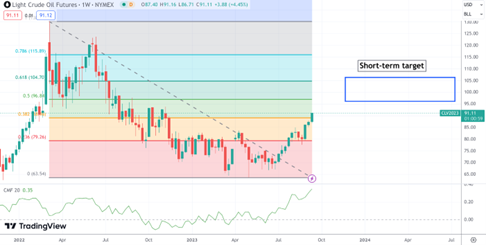- Saudi Arabia and Russia extend oil production cuts till the end of 2023, causing a spike in global oil prices.
- The decision might strain Saudi Arabia’s economy, making it potentially vulnerable to a downturn due to its heavy reliance on oil revenues.
- While the long-term outcome of the cuts remain unknown, the short-term bullishness of the situation may present a trading opportunity.
On September 5, Saudi Arabia and Russia announced that they are extending their crude oil production cuts by 1 million barrels a day until the end of 2023. The news jolted the crude oil market as prices soar to their highest levels of the year, reflecting concerns over tighter supplies in the face of robust global demand.
Why are they cutting production?
The public-facing rationale is that OPEC+ wants to stabilize the oil market by managing and potentially boosting oil prices. However, it’s also a well-known fact that the West’s sanctions on Russia include a price cap on oil. By implementing the OPEC+ production cuts, Russia is now able to raise global oil prices, which it needs to raise its revenues and support its invasion of Ukraine.
Why it matters to traders
Production cuts are likely to send oil prices to even higher levels. Plus, the cuts will likely impact global economies, and possibly lead to more strain on consumers and businesses. So, aside from watching the crude oil market, you may want to pay attention to how this impacts the three major indexes (the Dow, S&P 500, and Nasdaq 100 futures).
Reading between the lines
It’s an economic tug of war between OPEC+ and the rest of the world. Politically, it can also be seen as a tug of war between BRICS and the NATO-allied west.
But it’s also a gamble. These cuts could also weigh on Saudi Arabia’s economy, which is heavily reliant on oil.
There’s more too
Brent crude and U.S. West Texas Intermediate (WTI) has been seeing significant gains over the past weeks. The global market is watching closely as OPEC+, a major player in the global oil, adjusts its production levels monthly in response to a dynamic market.
More pain at the pump
American consumers have been feeling the ripple effects, as gas prices rise at the pump. The White House canceled several Alaskan oil and gas leases, and consumers are worried about an uptick in inflation.
What do the technicals say?

Looking at a weekly chart, we can see that CL recently broke above some basing action as money flow showed a tremendous increase in buying pressure (see Chaikin Money Flow line well above the zero-line). We can also see that the end of the year is only three months away.
The bears are probably thinking that the current surge in prices might be nothing more than a bear rally. Nobody knows what will unfold in the coming months, but we do know that the OPEC+ cuts are bullish for crude.
So the compromise here is to view it bullishly with caution. If you’re looking to swing trade CL as it continues to move upwards, you might want to set your price target carefully.
Once it reaches that target, check the news to see if there’s been any development with regard to the production cuts and US response to the cuts, and also check the Commitment of Traders report to see how institutionals, large funds, and retail traders are positioned in the market. Generally, you want to be positioned against the retail crowd once they’re net long or short.
The bottom line
OPEC+’s decision to extend oil production cuts until the end of 2023 has sent ripples across the global crude oil market. Their strategy is a risky maneuver aimed at stabilizing the oil market; risky because Saudi Arabia’s economy is heavily dependent on oil revenues, and such a move risks triggering an economic contraction.
While the immediate scenario is bullish for crude oil prices in the short-term, the long-term outcome has yet to unfold.
Please be aware that the content of this blog is based upon the opinions and research of GFF Brokers and its staff and should not be treated as trade recommendations. There is a substantial risk of loss in trading futures, options and forex. Past performance is not necessarily indicative of future results.
Disclaimer Regarding Hypothetical Performance Results: HYPOTHETICAL PERFORMANCE RESULTS HAVE MANY INHERENT LIMITATIONS, SOME OF WHICH ARE DESCRIBED BELOW. NO REPRESENTATION IS BEING MADE THAT ANY ACCOUNT WILL OR IS LIKELY TO ACHIEVE PROFITS OR LOSSES SIMILAR TO THOSE SHOWN. IN FACT, THERE ARE FREQUENTLY SHARP DIFFERENCES BETWEEN HYPOTHETICAL PERFORMANCE RESULTS AND THE ACTUAL RESULTS SUBSEQUENTLY ACHIEVED BY ANY PARTICULAR TRADING PROGRAM.
ONE OF THE LIMITATIONS OF HYPOTHETICAL PERFORMANCE RESULTS IS THAT THEY ARE GENERALLY PREPARED WITH THE BENEFIT OF HINDSIGHT. IN ADDITION, HYPOTHETICAL TRADING DOES NOT INVOLVE FINANCIAL RISK, AND NO HYPOTHETICAL TRADING RECORD CAN COMPLETELY ACCOUNT FOR THE IMPACT OF FINANCIAL RISK IN ACTUAL TRADING. FOR EXAMPLE, THE ABILITY TO WITHSTAND LOSSES OR TO ADHERE TO A PARTICULAR TRADING PROGRAM IN SPITE OF TRADING LOSSES ARE MATERIAL POINTS WHICH CAN ALSO ADVERSELY AFFECT ACTUAL TRADING RESULTS. THERE ARE NUMEROUS OTHER FACTORS RELATED TO THE MARKETS IN GENERAL OR TO THE IMPLEMENTATION OF ANY SPECIFIC TRADING PROGRAM WHICH CANNOT BE FULLY ACCOUNTED FOR IN THE PREPARATION OF HYPOTHETICAL PERFORMANCE RESULTS AND ALL OF WHICH CAN ADVERSELY AFFECT ACTUAL TRADING RESULTS.